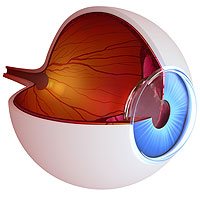
People with diabetes are well aware of the effects the condition can have on the body. Uncontrolled diabetes can wreak havoc on almost all systems in the body, and can affect your eyes negatively. While diabetic people who have their diabetes under close control are less likely to experience these issues, it is extremely common for diabetic patients to develop a condition called diabetic retinopathy.
What is Diabetic Retinopathy?
Diabetic retinopathy is an eye condition that occurs when high blood sugar levels cause damage to the blood vessels in the retina. The retina, a small patch of tissue that lines the back of the eye, is responsible for turning light into signals for the brain. In short, your retina is an essential part of your vision.
As diabetic retinopathy progresses, the tiny blood vessels on the retina begin to swell and leak fluid and blood. This fluid leaks into the eye cavity, obscuring vision. Eventually, new abnormal blood vessels begin to grow on the retina. These new blood vessels are fragile and leak easily, compounding the issue.
Stages of Diabetic Retinopathy
There are two main stages of diabetic retinopathy.
NPDR (non-proliferative diabetic retinopathy)
This is the early stage of the disease. Many diabetic patients have it. During the NPDR stage, the tiny blood vessels on the retina swell and may leak. This can cause the retina to swell. A secondary condition, called macular edema, can also occur. Macular edema occurs when the macula, the center of the retina responsible for central vision, begins to swell. This can cause extremely blurry vision and possible blindness.
PDR (proliferative diabetic retinopathy)
This is the advanced stage of the disease. When NPDR progresses to PDR, it means that the retina has started to grow new, abnormal blood vessels. This is called neovascularization.
Neovascularization can cause an increase in blood and fluid leakage, because the new blood vessels are weak and more likely to break. As blood enters the middle of the eye (the vitreous gel), dark spots of “floaters” can develop. Depending on the amount of blood in the eye, these can appear as small dots or can block vision completely.
Treatment for Diabetic Retinopathy
Treatment for diabetic retinopathy usually requires a combination of methods. In addition to treatments and surgeries, diabetic patients are encouraged to get their blood sugar under control. Treatments can only go so far if the root problem is not being addressed.
Besides controlling your blood sugar levels, your treatment may involve medications, injectable medicines and laser surgery. Treatment combinations typically vary from patient to patient depending on the severity of your condition.
Do you suspect you have diabetic retinopathy or are you looking for the perfect treatment plan? Contact one of our many PA locations in Scranton, Bloomsburg and more to schedule your diabetic retinopathy appointment! Our diabetic eye disease experts are here to help you maintain the best vision possible. Contact our Scranton, Berwick or Kingston, PA locations today!

















